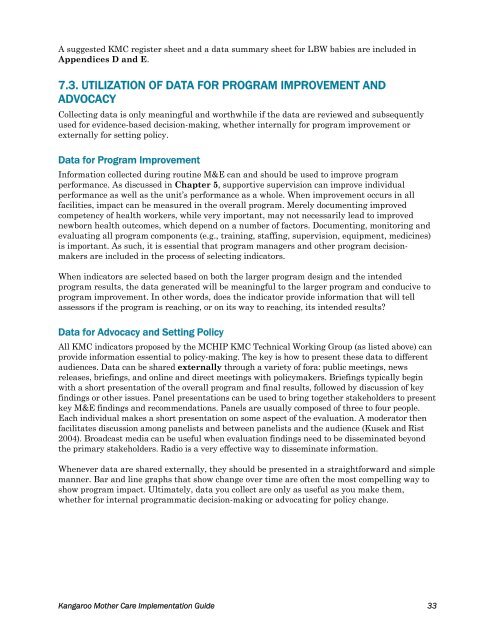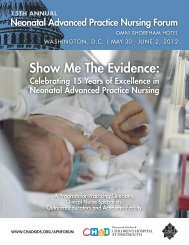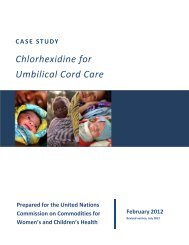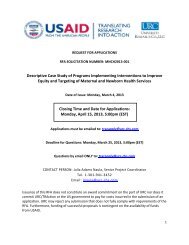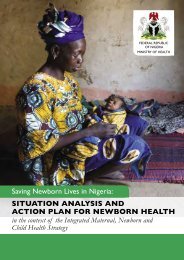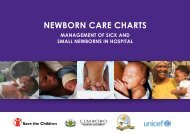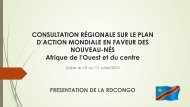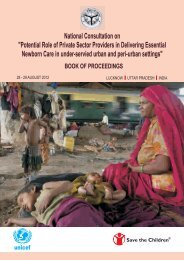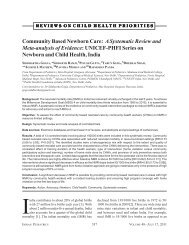Kangaroo Mother Care - MCHIP
Kangaroo Mother Care - MCHIP
Kangaroo Mother Care - MCHIP
You also want an ePaper? Increase the reach of your titles
YUMPU automatically turns print PDFs into web optimized ePapers that Google loves.
A suggested KMC register sheet and a data summary sheet for LBW babies are included in<br />
Appendices D and E.<br />
7.3. UTILIZATION OF DATA FOR PROGRAM IMPROVEMENT AND<br />
ADVOCACY<br />
Collecting data is only meaningful and worthwhile if the data are reviewed and subsequently<br />
used for evidence-based decision-making, whether internally for program improvement or<br />
externally for setting policy.<br />
Data for Program Improvement<br />
Information collected during routine M&E can and should be used to improve program<br />
performance. As discussed in Chapter 5, supportive supervision can improve individual<br />
performance as well as the unit’s performance as a whole. When improvement occurs in all<br />
facilities, impact can be measured in the overall program. Merely documenting improved<br />
competency of health workers, while very important, may not necessarily lead to improved<br />
newborn health outcomes, which depend on a number of factors. Documenting, monitoring and<br />
evaluating all program components (e.g., training, staffing, supervision, equipment, medicines)<br />
is important. As such, it is essential that program managers and other program decisionmakers<br />
are included in the process of selecting indicators.<br />
When indicators are selected based on both the larger program design and the intended<br />
program results, the data generated will be meaningful to the larger program and conducive to<br />
program improvement. In other words, does the indicator provide information that will tell<br />
assessors if the program is reaching, or on its way to reaching, its intended results<br />
Data for Advocacy and Setting Policy<br />
All KMC indicators proposed by the <strong>MCHIP</strong> KMC Technical Working Group (as listed above) can<br />
provide information essential to policy-making. The key is how to present these data to different<br />
audiences. Data can be shared externally through a variety of fora: public meetings, news<br />
releases, briefings, and online and direct meetings with policymakers. Briefings typically begin<br />
with a short presentation of the overall program and final results, followed by discussion of key<br />
findings or other issues. Panel presentations can be used to bring together stakeholders to present<br />
key M&E findings and recommendations. Panels are usually composed of three to four people.<br />
Each individual makes a short presentation on some aspect of the evaluation. A moderator then<br />
facilitates discussion among panelists and between panelists and the audience (Kusek and Rist<br />
2004). Broadcast media can be useful when evaluation findings need to be disseminated beyond<br />
the primary stakeholders. Radio is a very effective way to disseminate information.<br />
Whenever data are shared externally, they should be presented in a straightforward and simple<br />
manner. Bar and line graphs that show change over time are often the most compelling way to<br />
show program impact. Ultimately, data you collect are only as useful as you make them,<br />
whether for internal programmatic decision-making or advocating for policy change.<br />
<strong>Kangaroo</strong> <strong>Mother</strong> <strong>Care</strong> Implementation Guide 33


